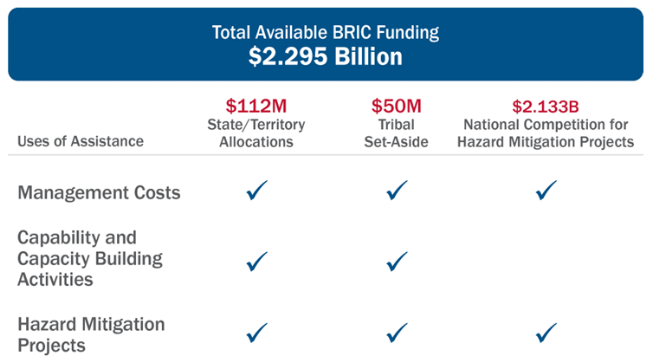The Federal Emergency Management Agency (FEMA) has announced its fiscal year 2022 (FY2022) application period for the Hazard Mitigation Assistance (HMA) Notices of Funding Opportunities (NOFOs) for the new Building Resilient Infrastructure and Communities (BRIC) grant program. The application period commenced on September 30, 2022.
With the recognition of the growing hazards associated with climate change and the need for natural hazard risk mitigation activities, FEMA will provide funding under the BRIC program to state, local, tribal, and territorial governments for projects that protect people and infrastructure from natural hazards and the effects of climate change.
Awards made under this NOFO will be made by appropriations under the Infrastructure Investment and Jobs Act, also more commonly known as the Bipartisan Infrastructure Law (BIL). This BIL is a once-in-a-generation investment in infrastructure that will grow a more sustainable, resilient, and equitable economy, ensuring stronger access to economic and environmental benefits for disadvantaged communities.
In Fiscal Year 2021, FEMA made $1.16 billion available for BRIC.1 This year, FEMA increased the total available funding, more than doubling BRIC levels to $2.295 billion for FY 2022.2
FEMA will distribute BRIC grant program awards to eligible BRIC applicants for the following activities:
- Capability- and Capacity-Building (C&CB) activities
- Hazard Mitigation Projects (construction) activities
- Management cost activities
|
 |
According to a FEMA fact sheet released on August 2022, changes to the FY 2022 funding opportunity were made to improve equity and reduce complexity.
To apply for available funding, applications must be received by FEMA by January 27, 2023. However, applications are typically due 30 to 60 days earlier to the State Recipient, who provides oversight and provides FEMA recommendations on the projects. As most states are now beginning to issue additional guidance, interested applicants are encouraged to check with their applicable state emergency management or resiliency entity for additional guidance on the process.
Last year, awarded projects were highly focused on combating climate change and protecting communities that are vulnerable to disaster, with 53 projects selected and a total award made of $1.16B from $4.16B in project requests received, making selection brutally competitive.
Some of the winning grants highlight the administration's focus on climate change:
- County of Nevada, California: $31.03 million – using nature-based solutions to provide critical protection from wildfires for some of the most vulnerable communities.
- South Florida Water Management, Florida: $50 million – optimizing structures and providing nature-based solutions to combat increased flood risk and sea-level rise threats in one of the nation's most rapidly growing areas.
- Lane County, Oregon: $2.70 million – providing rural residents with essential utility protection.
Many winning projects include a tagline of "This is a Justice40 Project." This means the project supports the Biden-Harris administration's promise to "ensure that at least 40% of federal climate investments go directly to frontline communities most affected by poverty and pollution."3 BRIC was selected as one of the federal programs to support this initiative and FEMA chose projects accordingly.
For a project to be considered a Justice40 project, and therefore increase the likelihood of being selected for a BRIC award by FEMA, potential BRIC applicants should identify whether their project will benefit a "disadvantaged community" as identified in the Climate and Economic Justice Screening Tool here. Competitive projects for the FY 22 BRIC selection will focus on climate-resilient projects, such as using natural resources to build resiliency, and benefiting disadvantaged communities.
Please contact Wendy Huff Ellard, Danielle M. Aymond, or Jaron Herd of Baker Donelson's Disaster Recovery and Government Services Team with any questions.
1 https://www.fema.gov/grants/mitigation/building-resilient-infrastructure-communities/after-apply/fy-2021-subapplication-status
2 https://www.fema.gov/sites/default/files/documents/fema_fy22-bric-nofo-fact-sheet_08122022.pdf
3 https://www.thejustice40.com/